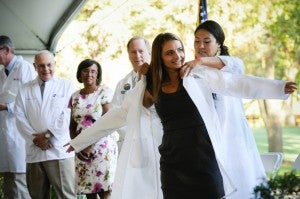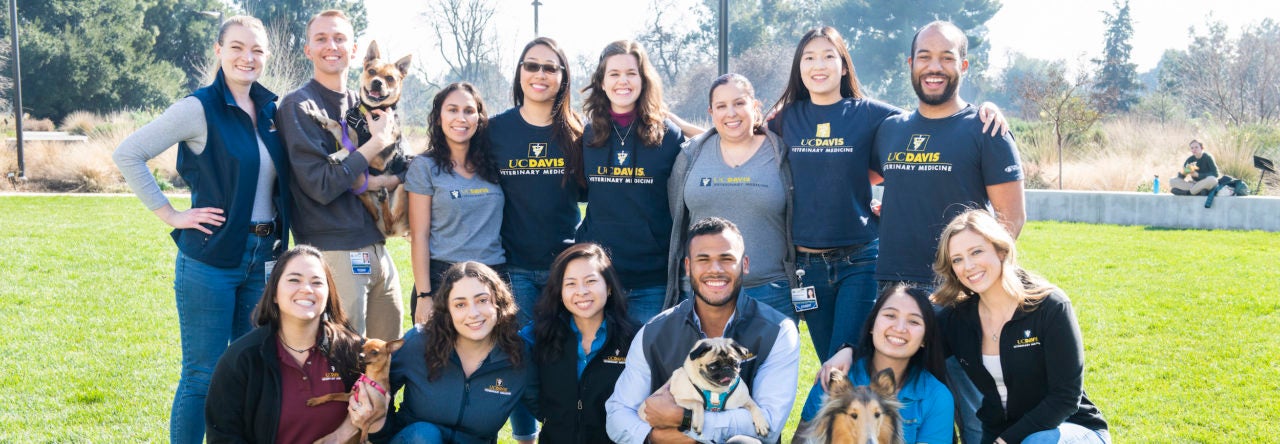“When you show deep empathy toward others, their defensive energy goes down, and positive energy replaces it. That’s when you can get more creative in solving problems.” – Stephen Covey
 Last week we welcomed the Class of 2019 into our school, the 68th class to begin their careers as veterinarians with us. I had the privilege of greeting them across the stage at our White Coat Ceremony and then engaging with a group of our new students in facilitating a problem-based learning exercise focused on effective client communications. A common theme throughout the orientation week and in early classes offered for our new students is relationship-centered, empathic listening as a key to client communications and positive animal-patient outcomes. During this important introduction to our school, Dr. Jim Clark, staff teams, and faculty facilitators effectively encouraged, guided, and inspired the first year students throughout the Prologue week and into their first week of classes.
Last week we welcomed the Class of 2019 into our school, the 68th class to begin their careers as veterinarians with us. I had the privilege of greeting them across the stage at our White Coat Ceremony and then engaging with a group of our new students in facilitating a problem-based learning exercise focused on effective client communications. A common theme throughout the orientation week and in early classes offered for our new students is relationship-centered, empathic listening as a key to client communications and positive animal-patient outcomes. During this important introduction to our school, Dr. Jim Clark, staff teams, and faculty facilitators effectively encouraged, guided, and inspired the first year students throughout the Prologue week and into their first week of classes.
 In our school, we have created many opportunities for our students to develop leadership and communication skills, knowing that this will make them better veterinarians and citizens. In teaching our students how to effectively communicate, we all have a chance to renew our commitment to excellence in empathic listening and learning. If we are not empathic to others, we will fail to form trust bonds and miss opportunities to connect and learn from them. Failure at listening deeply can circumvent our ability to do our jobs helping animals and humankind. So it is appropriate that we have focused a problem-based exercise in effective communications for our students’ first case.
In our school, we have created many opportunities for our students to develop leadership and communication skills, knowing that this will make them better veterinarians and citizens. In teaching our students how to effectively communicate, we all have a chance to renew our commitment to excellence in empathic listening and learning. If we are not empathic to others, we will fail to form trust bonds and miss opportunities to connect and learn from them. Failure at listening deeply can circumvent our ability to do our jobs helping animals and humankind. So it is appropriate that we have focused a problem-based exercise in effective communications for our students’ first case.
 This skill of empathic listening must also be practiced by our faculty and staff to reinforce the lessons we are teaching our students. Our behaviors exhibited in everyday activities are opportunities to demonstrate to our students that we care about listening to each other. In displaying how we care for each other, we are solidifying our message to our students, allowing us to be the role models they are looking for to guide their career development. In teaching communications, we ask our students to consider their role in fostering a relationship-centered approach to client communications as a way to become more effective practitioners. My student group found a large body of literature on this subject and vigorously discussed the implications if we failed to connect to our human clients. Verbal and non-verbal communications and messages were found to be critical components to reduce anxiety and create better outcomes for our animal patients. We can all learn from our students’ experiences and refresh our commitment to listening more effectively to be understood. This will enhance our work environments and produce more creative ways to solve the problems in our daily jobs and in our society.
This skill of empathic listening must also be practiced by our faculty and staff to reinforce the lessons we are teaching our students. Our behaviors exhibited in everyday activities are opportunities to demonstrate to our students that we care about listening to each other. In displaying how we care for each other, we are solidifying our message to our students, allowing us to be the role models they are looking for to guide their career development. In teaching communications, we ask our students to consider their role in fostering a relationship-centered approach to client communications as a way to become more effective practitioners. My student group found a large body of literature on this subject and vigorously discussed the implications if we failed to connect to our human clients. Verbal and non-verbal communications and messages were found to be critical components to reduce anxiety and create better outcomes for our animal patients. We can all learn from our students’ experiences and refresh our commitment to listening more effectively to be understood. This will enhance our work environments and produce more creative ways to solve the problems in our daily jobs and in our society.
